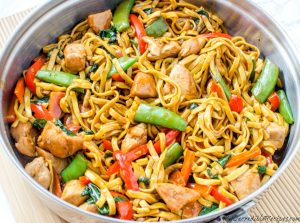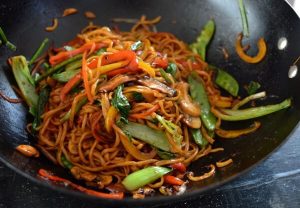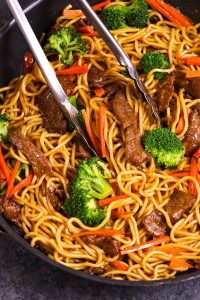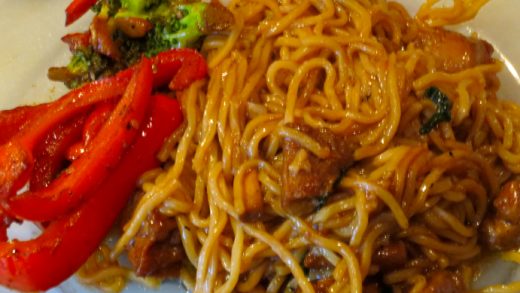The Chinese invented pasta and you will find noodles and dumplings all across Asian cuisine. But nothing you will get at most Chinese restaurants in the U. S. is really Chinese; they are adapted to American tastes and ingredients. So, what you are really eating is Chinese American food.

You do not need to order take-out or delivery, you can easily make your own Chinese-American favorites at home. One popular and easy dish is lo mein. The word lo means simple or obvious. Mein (pronounced “main”) means a type of wheat noodle or pasta. So, the English name for this dish would be “Obvious noodle.”
Lo mein is an easy, simple and versatile dish. You can use different combinations of meats and vegetables to keep it interesting. Like most stir-fry dishes, most of your time is taken up with chopping. Also, you will need a few ingredients from the Asian food aisle in the grocery store that you may not have in your pantry. And you should make them a part of your pantry because they can be used for so many different foods. You can save a lot of time by using frozen vegetable mixes (without sauce) and leftover meat that just needs cutting into bite-size pieces. Most lo mein uses long noodles, like spaghetti or linguini. But you can experiment with other pasta shapes if you like. Very thin kinds of pasta like angel-hair or thin spaghetti are not recommended as they could get overcooked or break apart.

As with any pasta dish, the first step is always putting a big pot of water on the heat to reach a boil. When it hits the boil, add several heavy pinches of salt. Follow the directions for al dente pasta you’ll find on the package. Eight ounces of pasta will take about 10 to 12 minutes to cook. Drain and place the hot noodles in a bowl. Stir in about a teaspoon of toasted or dark sesame oil. Remember that this strong-flavored oil is more of a condiment than cooking oil. Make sure all the strands are coated. Then put a plate on top of the bowl to keep the noodles warm.
Now comes the time to heat up a wok or large skillet. Medium-high heat should get it to the right temperature without making it too hot to cook with later on. Once the pan is hot, add a tablespoon of oil. Most restaurants use peanut or soybean oil because most Chinese cooking is done over high heat. You can use any neutral-flavored oil. We like soybean oil the best. We don’t like canola oil unless we’re cooking seafood. When the oil is hot, add four cloves of garlic you have minced. We like to buy already minced garlic that comes in a jar as a time saver and something that does not go bad very quickly like fresh garlic. Also, add a tablespoon of fresh, minced ginger. You could replace it with about a teaspoon of powdered ginger but use a light touch. These will cook very, very quickly. Stir frequently for about 30 seconds until you can smell the mixture. Stir in about four-cups of mixed vegetables, fresh or frozen. Cook and stir for about three minutes or until slightly tender.

Next, we consider the protein. Our recipe calls for beef flank steak, but you could use almost any meat. We don’t recommend fish because it will fall apart. But this is a great use of leftovers, which cuts back on the cooking time by a few minutes. You need about a quarter-pound per person or serving and we usually make three to four servings. This dish makes good leftovers if you keep the noodles separate from the meat-vegetable sauce. Just make sure the meat is cut into bite-size pieces. If using a tougher cut of meat, like the aforementioned flank steak, slice very thinly against the grain of the meat so it is not too chewy and cooks quickly.
Stirring the meat and vegetables, cook until everything is cooked through, about five minutes.
Whisk together a quick sauce of three tablespoons low-sodium soy sauce, a couple tablespoons of brown sugar, a tablespoon of oyster sauce (We suppose any fish sauce would work, but you should find this in the Asian food section. It’s worth the fridge space.) and a tablespoon of Asian chili paste (we like Thai style). Pour this mix over the noodles and toss briefly. Pour into the wok with the now cooked vegetables and meat. Cook and stir until the pasta is hot, just a couple minutes.
This is healthy, because of the vegetables, and it is not, because of the sweet sauce. But when you’re craving Chinese-American food, this is as good as any you can buy.
